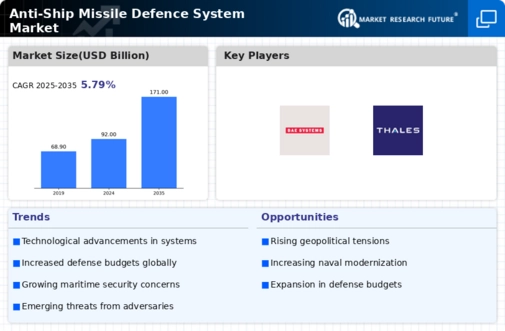Market Trends
Key Emerging Trends in the Anti-Ship Missile Defence System Market
The market dynamics of the anti-ship missile defense system market present a complex landscape driven by various factors. At its core, the demand for such systems is fueled by the increasing threats posed by hostile maritime activities and the need to safeguard naval assets. As nations seek to bolster their maritime security capabilities, investments in advanced anti-ship missile defense systems surge. This trend is particularly pronounced in regions with geopolitical tensions and strategic maritime interests, such as the Asia-Pacific and the Middle East.
One of the primary drivers shaping the market dynamics is the evolving nature of maritime threats. The proliferation of advanced anti-ship missiles, including supersonic and hypersonic variants, poses significant challenges to naval forces worldwide. Consequently, there's a growing emphasis on developing and deploying robust defense systems capable of detecting, tracking, and intercepting incoming threats in real-time. This has led to a surge in research and development activities aimed at enhancing the effectiveness and efficiency of anti-ship missile defense systems.
Moreover, technological advancements play a pivotal role in driving market dynamics. With rapid innovations in sensor technologies, radar systems, and missile interception capabilities, defense contractors are constantly striving to stay ahead of emerging threats. Integration of cutting-edge technologies such as artificial intelligence, machine learning, and network-centric warfare further enhances the capabilities of anti-ship missile defense systems, making them more resilient and adaptable to evolving threat scenarios.
Geopolitical factors also exert a significant influence on the market dynamics of anti-ship missile defense systems. Heightened tensions in key maritime chokepoints, territorial disputes, and the resurgence of great power competition drive nations to bolster their naval capabilities, including robust missile defense systems. As a result, defense spending in this sector continues to rise, with governments allocating substantial budgets to procure, upgrade, and maintain anti-ship missile defense assets.
Furthermore, market dynamics are shaped by the evolving strategies of defense contractors and suppliers. Intense competition in the defense industry incentivizes companies to innovate and differentiate their offerings to gain a competitive edge. This has led to the emergence of diverse product portfolios, ranging from standalone missile defense systems to integrated naval warfare suites capable of countering multifaceted threats. Collaborations, partnerships, and mergers and acquisitions are also common strategies employed by defense firms to enhance their market presence and capabilities.
However, market dynamics are not without challenges and constraints. Budgetary constraints, especially in light of the economic impact of global crises such as the COVID-19 pandemic, pose significant hurdles to defense procurement programs. Additionally, regulatory frameworks, export controls, and geopolitical alliances influence market dynamics by shaping the flow of defense technologies and systems across borders.






Leave a Comment